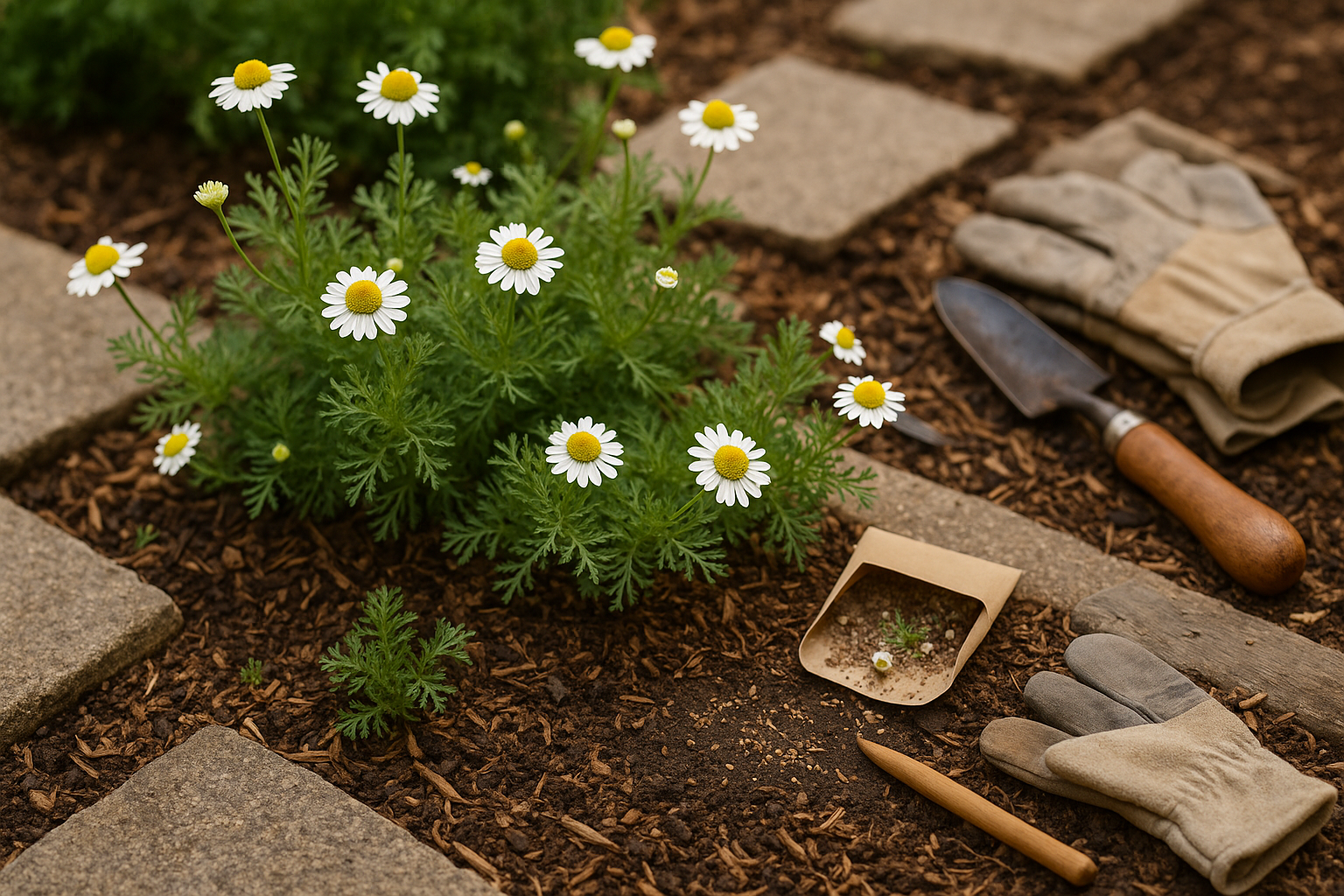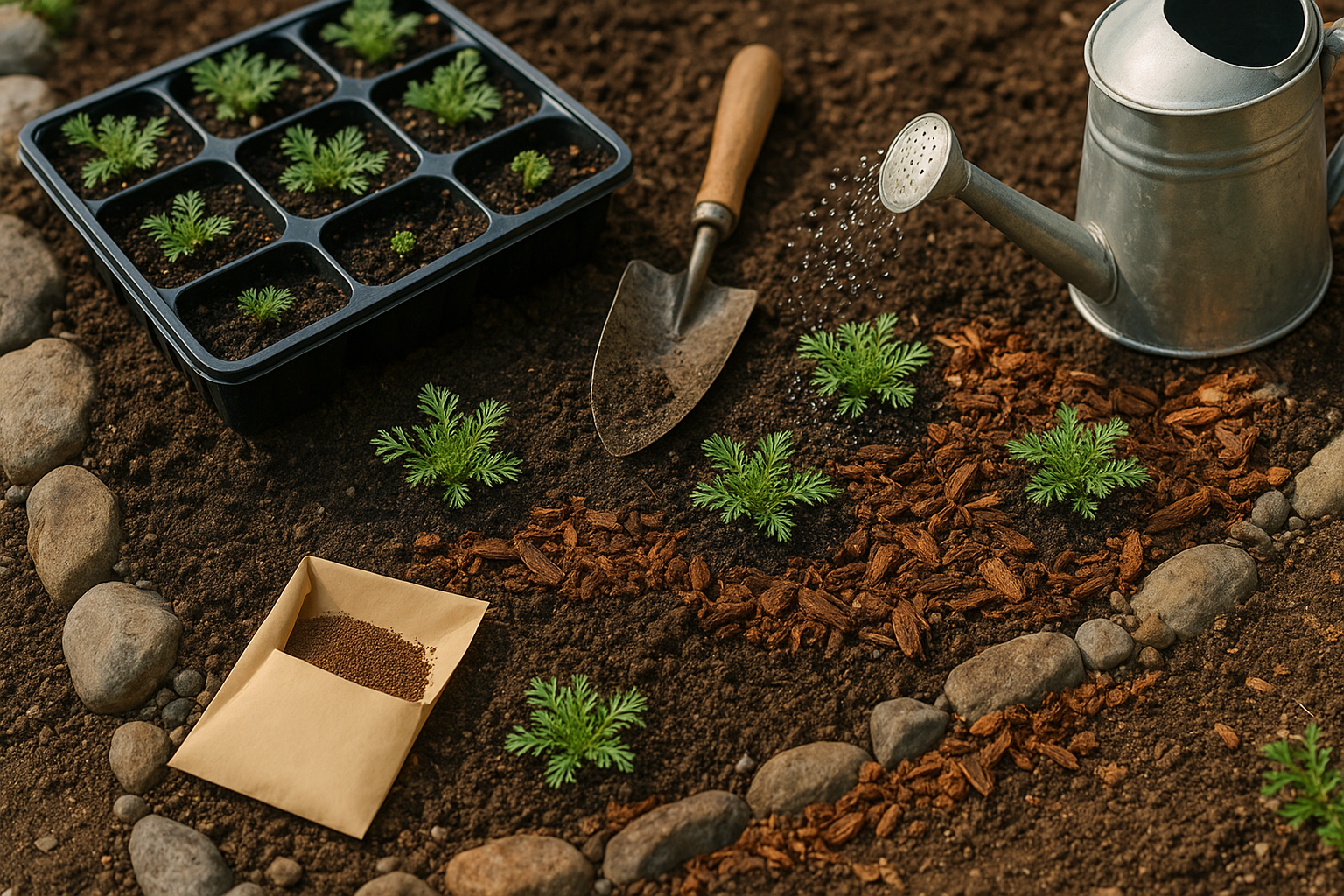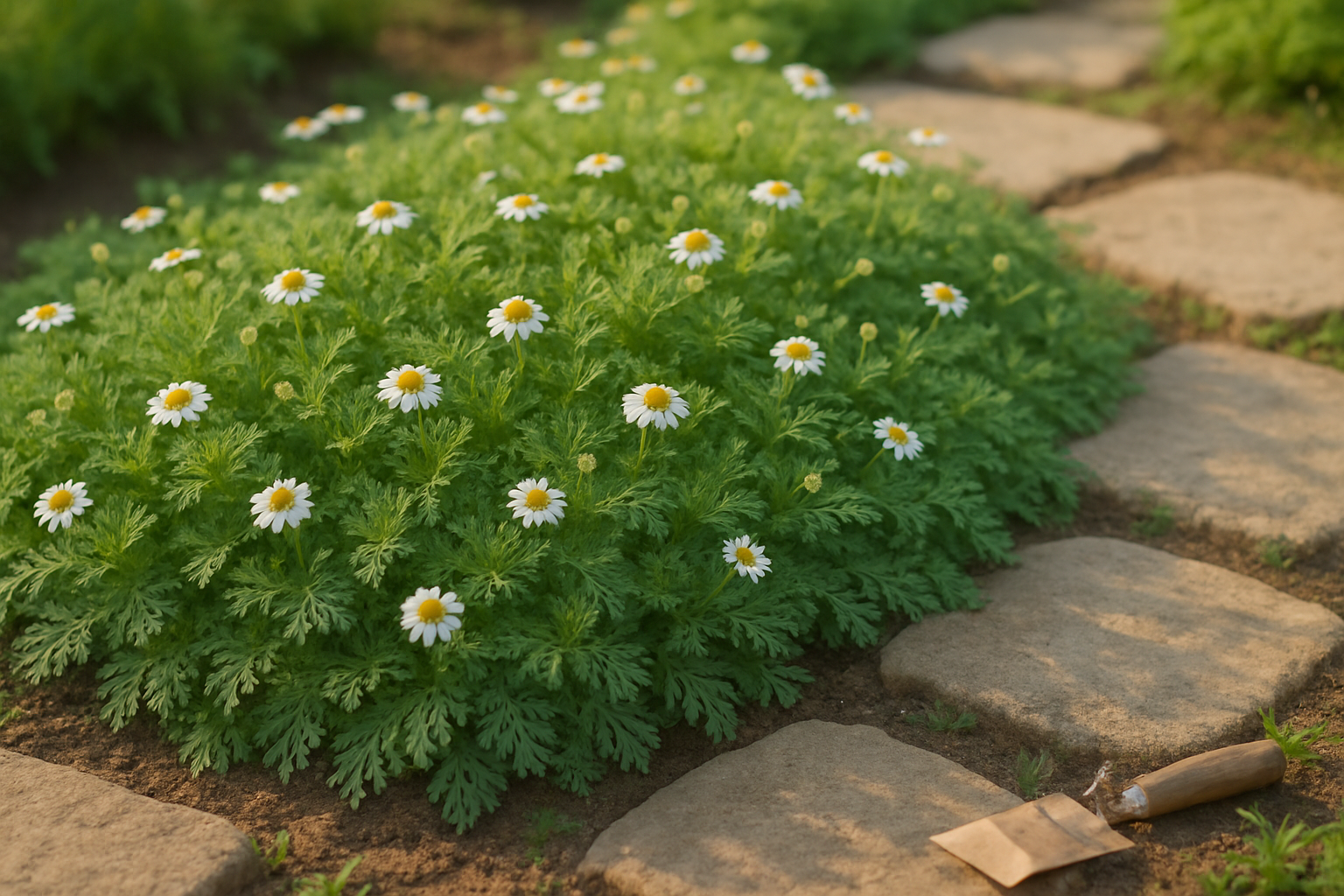Introduction

If you’re searching for a beautiful, easy-care solution for bare spots in your landscape, you’ll want to consider chamomile groundcover. Roman chamomile, in particular, stands out with its lush, fern-like foliage and sweet, apple-like aroma, making it a favorite among gardeners and landscapers alike.
Unlike grass, this hardy perennial stays low to the ground and thrives even in high-traffic areas, making it perfect for lining garden pathways or filling gaps between stepping stones. One of the biggest draws of chamomile groundcover is its resilience—it tolerates dry soil, occasional foot traffic, and even some neglect, bouncing back with a carpet of tiny, daisy-like flowers each spring and summer.
The benefits go beyond looks. Its calming fragrance not only delights people passing by but also naturally deters some garden pests. Pet owners appreciate its non-toxic nature, meaning playful paws and curious noses can explore freely.
Urban gardeners with small plots can use Roman chamomile to maximize every inch, while professional landscapers favor it for covering large slopes or hard-to-mow areas. Whether you’re designing a pet-friendly backyard, updating cottage gardens, or aiming for eco-friendly, low-maintenance landscaping, Roman chamomile groundcover offers a simple, attractive solution that suits a variety of outdoor spaces.
Understanding Roman Chamomile
Roman chamomile (Chamaemelum nobile) is a charming, low-growing perennial herb prized for its dainty, apple-scented foliage and cheerful, daisy-like white flowers with bright yellow centers. Typically, Roman chamomile stays quite compact, reaching about 4 to 12 inches in height and spreading gently up to 18 inches, making it an ideal choice for a fragrant, living groundcover.
Its fine, feathery leaves form a dense mat that can handle light foot traffic, perfect for planting between stepping stones or as a lawn alternative in sunny, well-drained spots. Roman chamomile’s evergreen nature in mild climates means it offers year-round texture and color, a big plus for gardeners seeking low-maintenance beauty.
It’s easy to confuse with German chamomile (Matricaria chamomilla), but the two have key differences:
- German chamomile is an annual that grows upright, reaching up to 24 inches or more and is best suited for loose flower beds or herbal tea harvest rather than groundcover.
- Roman chamomile hugs the ground with a creeping habit, spreading via runners and forming a plush, aromatic carpet over time.
If you want a hardy, soft, and sweet-scented groundcover that invites bees and butterflies, Roman chamomile is a standout choice over its taller, more delicate cousin. For best results, snip it back lightly after flowering to encourage lush regrowth and keep weeds at bay—both practical and rewarding ways to maximize your groundcover’s magic.
Choosing the Right Spot for Roman Chamomile
When selecting the best spot to plant Roman chamomile, keep a few key factors in mind to ensure healthy, lush growth. This fragrant herb thrives in full sun but can tolerate partial shade, especially in hotter climates where some afternoon relief helps prevent scorched foliage.
Aim for a location with well-draining, sandy, or loamy soil; Roman chamomile doesn’t tolerate soggy conditions, so avoid areas where water pools after rain. Raised beds or gentle slopes are ideal for keeping excess moisture at bay.
Since Roman chamomile spreads and forms dense, low-growing mats, consider where you might want a soft, carpet-like effect. It’s a fantastic choice for planting between stepping stones, as a gently fragrant groundcover along pathways, or even as a whimsical alternative to a traditional lawn in small garden areas.
Its low profile and soft texture invite barefoot walks, making it perfect for informal seating nooks or relaxation zones. Roman chamomile also pairs well with drought-tolerant Mediterranean plants like lavender, thyme, and oregano, creating a cohesive, easy-care border or herb garden.
Avoid planting it near aggressive groundcovers that could compete for space and light. If you want tidy edging, use garden borders or stone pavers to contain its spread. With the right location and thoughtful placement, Roman chamomile rewards gardeners with a resilient, beautifully scented, and visually appealing groundcover.
Step-by-Step Guide to Planting Roman Chamomile as Groundcover

To plant Roman chamomile as a lush groundcover, you’ll first need a few basic tools and supplies: a gardening spade or fork, rake, watering can or hose with a gentle spray, gardening gloves, compost or well-rotted manure, mulch (like straw or fine bark), seeds or small starter plants, and a trowel for transplanting.
Start by picking the right spot—Roman chamomile thrives in full sun but can tolerate partial shade, and prefers well-draining, moderately fertile soil. Spring is the best time to plant, after your last expected frost.
Begin by loosening the top six inches of soil with your spade or fork, breaking up large clumps, and mixing in a couple of inches of compost to improve fertility and drainage. Rake the bed smooth.
If you’re sowing seeds, scatter them thinly over the soil surface, then gently press them in with your palm or a board rather than covering them deeply—chamomile seeds need light to germinate. Mist gently with a fine spray to settle them; keep the soil consistently moist but not soggy.
For starter plants, dig holes about six to eight inches apart (chamomile likes to spread), set in each plant, backfill, and firm the soil around them. Water well to help roots settle.
Mulching after planting helps retain moisture and suppress weeds, but avoid crowding mulch directly against stems.
Aftercare
- Water newly sown or planted chamomile lightly every couple of days to keep the soil evenly moist, reducing frequency as the plants establish.
- Fertilizing isn’t usually necessary if you added compost at planting, but a light feeding with half-strength organic fertilizer in early growth can give them a boost.
- As plants fill in, thin seedlings if they look crowded, aiming for about eight inches between mature plants for air flow and healthy spreading.
- Watch moisture levels, pull weeds regularly, and keep an eye out for pests to ensure your Roman chamomile forms a fragrant, soft, and resilient green carpet.
Caring for Your Chamomile Groundcover
Caring for chamomile groundcover is refreshingly simple, but consistent attention will help your planting thrive year-round. Watering is the top priority, especially as tiny seedlings get established—keep the soil gently moist by watering every couple of days during dry spells.
Once mature, chamomile is surprisingly drought-tolerant; in most climates, a deep soak once a week in spring and summer is plenty. You can scale back significantly during the cooler, rainier fall and winter months. Be mindful not to overwater, as soggy roots can cause rot—always check the top inch of soil and water only when it feels dry.
Pruning and Thinning
Pruning and thinning are key to lush, even growth. Trim spent blooms and leggy stems with garden scissors every few weeks. This not only encourages denser foliage but can also extend the blooming season. If your groundcover becomes patchy or too dense in places, gently thin out overcrowded sections by hand in early spring. For larger areas, a light pass with the mower set on its highest setting after flowering can help keep things tidy and uniform.
Pests and Diseases
Chamomile is fairly resistant to pests and diseases, making it a popular choice for low-maintenance gardens. However, keep an eye out for common issues like aphids or powdery mildew—yellowing leaves or a powdery look on the stems are early warning signs. Remove any badly affected plants and consider introducing ladybugs or beneficial insects as natural pest control.
Because good airflow helps prevent most diseases, avoid letting patches get too thick or shaded. With a little routine upkeep and occasional check-ins, your chamomile groundcover will flourish beautifully, providing fragrant, soft greenery all season long.
Harvesting and Maintaining Chamomile
Selective harvesting of chamomile blooms is key to enjoying fresh tea and vibrant crafts without harming your plants’ lush groundcover. To do this, pinch or snip the mature, open flowers in the late morning after any dew has dried—this ensures the highest oil content and flavor.
Avoid pulling blooms forcefully, as this can disturb the stems and roots, leading to thinned patches. Instead, use a small pair of scissors or your fingertips, and leave the newer buds to continue growing for a steady supply throughout the season.
Annual Maintenance
Set aside time in early spring or fall to divide established clumps of chamomile, especially if you notice the center thinning out or reduced vigor. Gently pull sections apart and replant in bare areas or share with friends.
After heavy harvests or thinning, rake lightly and sprinkle a handful of seeds to reseed bare patches—pressing seeds gently into the soil since chamomile likes light exposure for germination.
Keep the area weeded and mulch thinly to retain moisture without smothering new sprouts. Water newly seeded or transplanted areas consistently until established, but avoid overwatering, as chamomile prefers somewhat dry conditions.
A light trim after full bloom can encourage bushier regrowth and a tidier appearance.
By rotating your harvests, dividing plants, replenishing seeds, and maintaining clean, well-drained beds, your chamomile patch will thrive with fragrant blooms and healthy foliage for years to come.
Troubleshooting and Common Problems
Even the most well-tended groundcovers can encounter a few snags. Patchiness is a common issue, often caused by poor soil, insufficient sunlight, or uneven watering. To fix this, rake out dead spots, amend the soil, and overseed or replant bare areas as needed—ideally in early spring or fall for the best results.
Pests like aphids or slugs may nibble on young leaves. Remove them by hand, use gentle insecticidal soap, or introduce beneficial insects such as ladybugs. Fungal problems, such as powdery mildew or root rot, thrive in damp, crowded environments. Combat these by watering early in the morning—directly at the soil level—and allowing plenty of space between plants for good airflow. Regularly clear debris to reduce habitat for weeds and pests.
If problems persist despite your efforts, or if the plants’ health declines season after season, it might be time to reassess your groundcover variety. Sometimes, poor performance indicates that the species isn’t well matched to your climate or soil. In such cases, don’t hesitate to dig up struggling patches and replace them with hardier, low-maintenance options like creeping thyme or sedum.
Proactive care—proper water management, good spacing, and quick responses to issues—goes a long way in keeping your groundcover lush and healthy throughout the year.
